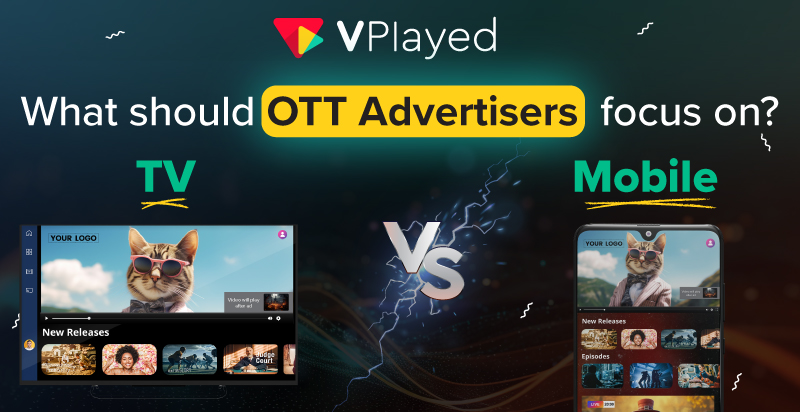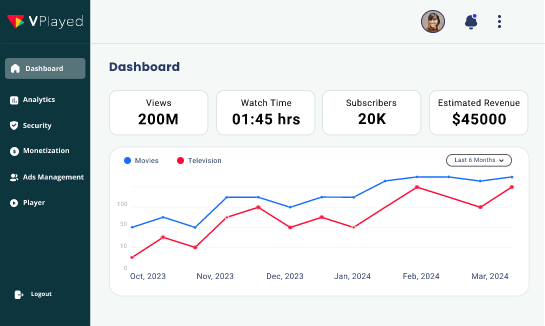TV vs Mobile – What Should OTT Advertisers Focus on?

“Do you find yourself watching ads more on mobile or TV?”
Ads have been present for ages now. Ever since the advent of television, monetization via ads has remained a rewarding way to generate sizable revenue.
And, as the video landscape slowly & steadily moved to streaming, AVOD (Advertising Video-on-Demand) became an evident revenue model most OTT apps monetize content with. Especially with free content, ads seem to drive more users than with subscriptions.
Now, there comes a pressing question that both OTT players & advertisers should focus on to reap the best results from ad-based content; is it going to be on Mobile apps or TV apps?
Table of Contents
Mobile Vs TV Apps for OTT Advertising
Over 82% of total Internet consumption of today is contributed to video. As we narrow down, it gets to crossroads as to where AVOD monetization can perform the best!
Here’s a realistic comparison of where mobile or TV apps are most suitable for OTT advertisers.
AVOD Monetization in Mobile Apps
Be it Android or iOS, mobile video consumption is hitting skyrocket & hence the perks are more with a few challenges as well.
Every third person today owns a smartphone. And, OTT apps are more than keen on targeting viewers via mobile apps because of the wider reach. And with ad-supported mobile content, the target user base is much bigger compared to other mediums.
Secondly, it is the penetration of 5G that makes mobile apps most convenient for streaming. The higher viewer time, higher is the ad engagement and conversion rate.
While ad blockers or using apps that restrict non-skippable ads might come as a hindrance to AVOD monetization, the flexibility and convenience in mobile viewing makes advertisers target viewers on mobile OTT platforms.
Different AVOD Monetization Options (Mobile)
The various ad styles that can be monetized on mobile OTT apps are:
1. Interstitial ads
These are full screen ads that require the user to take an action before proceeding to the content. This is very common with mobile apps.
2. Banner ads
Used for mobile display campaigns, banner ads appear on top, bottom, or side of the app before or while the video is playing on a mobile device.
3. Pre-roll, mid-roll & post-roll video ads
These ads closely appear with the video content and appear at the beginning, middle, or end of the video content that can either be skippable or non-skippable.
4. In-app ads
These are personalized ads that may appear as a display or playable based on what the user sees or doing. Very personalized form of ad delivery.
AVOD in TV Apps
Ads have forever existed on TVs. People are literally used to watching advertisements on television sets and it is something we’ve never wanted to skip.
Ads are hardwired into the DNA of content consumption. Hence, ads on TV apps are a sure-shot success as the Connected, smart TV & IPTV app segment are growing steadily across countries.
However, one of the challenges OTT advertisers might face is the competition among streaming players and traditional broadcasters who showcase ads. While both the spaces are diverse and equally beneficial, there is a constant battle between choosing traditional broadcast channels and OTT TV apps for placing an advertisement.
Different AVOD Monetization Options (TV Apps)
The various ad styles that can be monetized on mobile OTT apps are:
1. Ad Stitching
Video ads are being stitched as a single stream and appear seamlessly playable alongside the original video rather than looking obvious and intrusive.
2. Bumper or Non-skippable Ads
Since television channels are prone to ads, TV apps serve short bumper ads that last only a few seconds for branding purposes.
3. Programmatic TV Ads
These ads are inserted based on recommendations and are personalized upon user behavior. Programmatic TV ads are AI driven.
4. Pre-roll, mid-roll & post-roll Ads
Similar to mobile apps, video ads are placed in different fashions in TV apps as well.
5. OTT TV Ads
These over-the-top commercials are placed based on the streaming device such as Apple TV, Firestick, or Roku and targets only those particular set of viewers.
The Verdict
AVOD monetization has a lot of upsides. They add great value to free content. This is why in the past few years, ad-based monetization has been doing well besides subscriptions. 3rd party ad vendors find OTT apps the best way to target the GenZ crowd and the fact is undeniably true.
Now, coming back to our topic, with mobile advertising, advertisers reach more and OTT players accommodate more space to run ads. However, ads on mobile devices can be a bit intrusive compared to those on TV apps. On the other hand, users are ok with viewing commercials and don’t usually find them intrusive, hence are not skipped. So, if reaching a larger target audience is your aim, go for mobile app advertising and if it’s niche ad viewers you are looking for, target the TV app section for best AVOD outcomes.
If You Already Have An Idea About Starting A OTT App, Schedule A Free Demo And We’ll Get You On The Road To OTT App Success!
